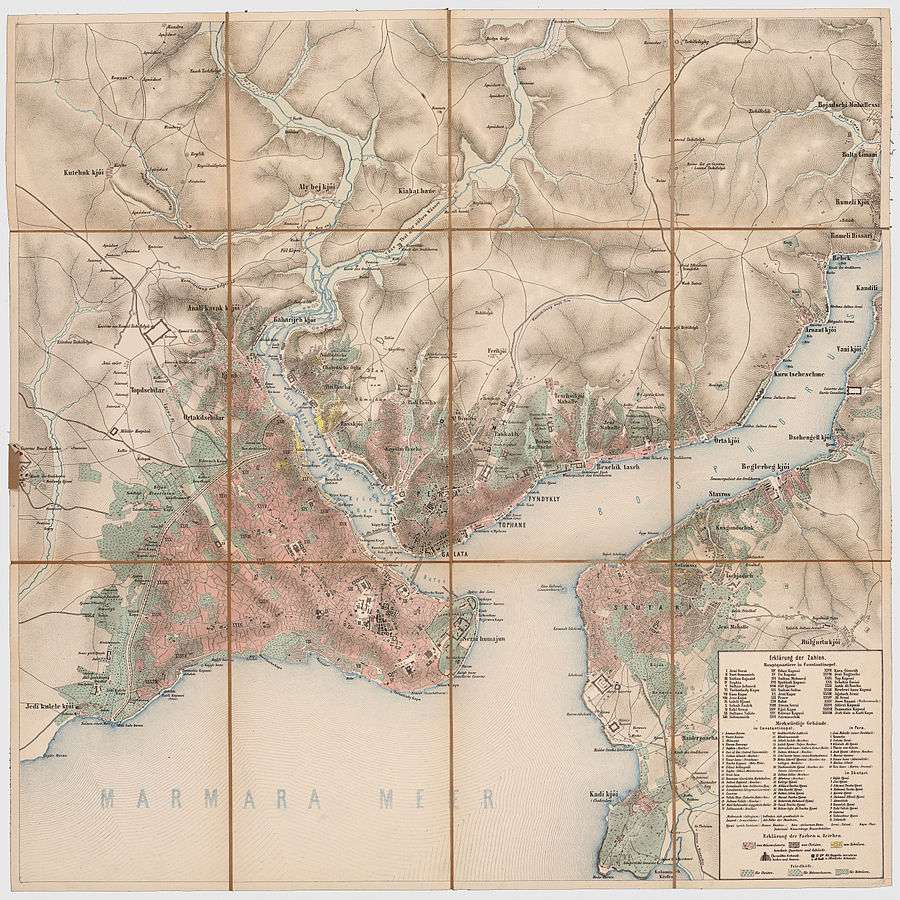Cossack raid on Istanbul (1615)
Cossack Istanbul raid of 1615 was a campaign of the Zaporozhian Cossacks, headed by Hetman Petro Konashevych-Sahaidachny. The attack successfully penetrated the capital of the Ottoman Empire, entered its harbor, and burned ships before returning to their base. The success of this raid inspired the Tutora campaign of 1620 and the Khotyn campaign of 1621.[1]
| Raid on Istanbul (1615) | |||||||
|---|---|---|---|---|---|---|---|
 Map in Scutari (now: Üsküdar), part of Istanbul attacked by Ukrainian Cossacks. | |||||||
| |||||||
| Belligerents | |||||||
|
|
| ||||||
| Commanders and leaders | |||||||
| Petro Konashevych-Sahaidachny | Prince Unknown (Assault) Ali-pasha | ||||||
| Strength | |||||||
| ~4,000 | ? | ||||||
Raid
The Cossack societies emerged in the fourteenth century in the Ukrainian wild steppes and near the Dnieper River. These were composed largely of runaway serfs initially, and the population was further augmented by adventurers. Later on, the Cossacks developed highly militaristic societies largely in response to the Tatar raids. Its fighters were considered formidable and surrounding states such as the kingdom of Poland employed them in times of conflicts.[2] During the 1500s they were also constantly attacking the Crimean Tatars and Ottoman possessions either to plunder treasure or liberate Christian slaves.[3] By sixteenth and seventeenth centuries, the fighters began raiding communities in the Black Sea. These included the cities of Varna, Perekop, Bilhorod, Izmail, and the Turkish Trebizond, among others.
In May 1615, Cossacks on eighty small boats (Ukr. Chaykah), each one carrying about 50 men, went on trip to Turkey. By mid-June they managed to cross the Black Sea and land on the coast in the vicinity of Istanbul. After that, the Cossacks captured and set on fire the Istanbul neighbour of Scutari (now: Üsküdar), followed by the ports of Mizevna and Archiuca. Having sacked the city, the Cossacks went back to Ukraine.
However, Sultan Ahmed I, from the windows of his palace saw the smoke from the fire caused by the raiders and sent a flotilla of Turkish galleys in pursuit. The Ottomans caught up with the Cossacks opposite the mouth of the Danube. The Turkish forces were, however, defeated after the Cossacks lured the Ottoman admiral Jigalazade Mahmud so close to the shore so that the fleet ran aground.[4] The admiral was captured.
Consequences
In order to punish the Zaporozhians, Turkish sultan sent the Flotilla next year under the command of Admiral Ali-Pasha. Turkish galleys crossed the sea and entered the Dnipro estuary, where they were met by Cossack boats under Petro Konashevich-Sagaidachny. Zaporozhians defeated the Turkish squadron, seized a dozen galleys and nearly a hundred boats. Commander Ali-Pasha barely managed to escape with his life.
After that, the Cossacks again went to sea, round the Crimea and landed on the shore near the largest Black Sea slavery market - Kafa. Thus, the attack on Istanbul went into collision, went down in history as a battle for Kafa.
Psychological factor
The raid was a morale boost to the Zaporozhians Cossacks, who were successful where the Holy Roman Empire and the Polish–Lithuanian Commonwealth didn't dare. European diplomats brought news of the Cossack raid to the West. French historian Michel Baudier wrote: "le seul nom des Cosaques était l'effroi et la terreur de Constantinople" ("The only mention of the Cossacks brings dread and terror to Constantinople").
Sources
- 1. Крип'якевич І., Гнатевич Б. та ін. Історія українського війська. – Львів, 1992. – С.193-194
- 2. "Cossack Navy 16th - 17th Centuries". geocities. Archived from the original on 26 October 2009.
References
- Stone, Daniel (2014). The Polish-Lithuanian State, 1386-1795. Seattle: University of Washington Press. p. 146. ISBN 0295980931.
- Prazmowska, Anita (2011). A History of Poland. New York: Palgrave Macmillan. p. 102. ISBN 9780230252356.
- Stone, p. 146.
- Imber, Colin (2009). The Ottoman Empire, 1300-1650: The Structure of Power. New York: Palgrave Macmillan. p. 66. ISBN 0230574505.